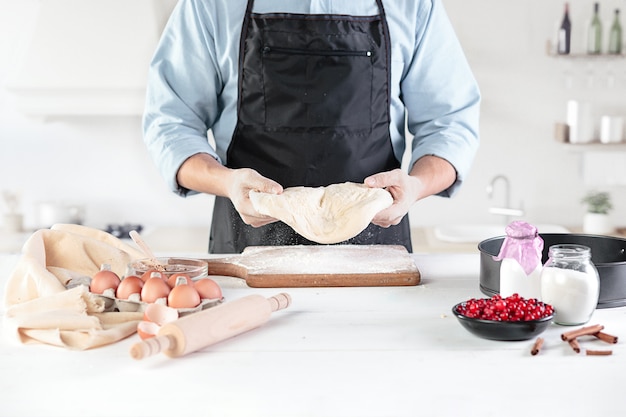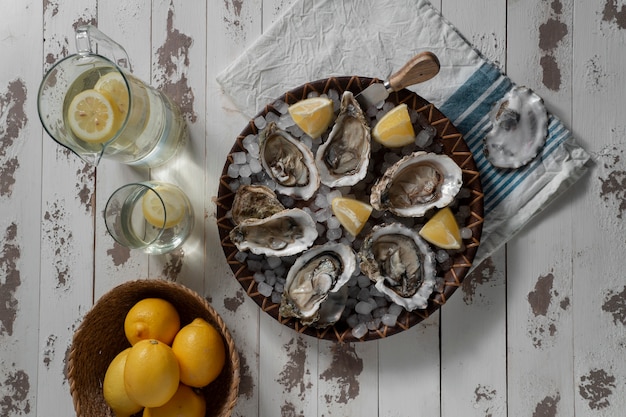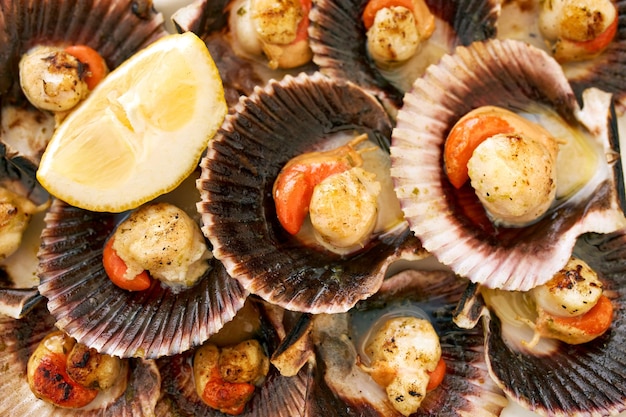Scallops. Just the word conjures up images of those beautiful, pearly-white shells, promising a taste of the ocean's bounty. And for good reason! There's something undeniably luxurious about a perfectly cooked scallop, with its tender, juicy flesh and the satisfying crunch of its caramelized edges. But let's be honest, the prospect of cooking scallops can be a bit daunting. You've got those delicate little gems, and you're thinking, "Do I even know how to handle this?"
Well, fear not! I'm here to demystify scallop cooking and show you how easy it can be to create truly delicious dishes. Over the years, I've experimented with countless methods, from the classic pan-fry to the adventurous grill. And let me tell you, there's a perfect technique for every palate and every occasion.
This guide is your roadmap to scallop success, covering everything from picking the right scallops to prepping them for cooking. We'll explore various cooking methods, share insider tips, and even dive into some delicious flavour combinations. Get ready to elevate your culinary game and impress your friends with stunning scallop creations. So grab a comfy chair, pour yourself a cuppa, and let's embark on a culinary journey that will leave you craving more!
(Part 1) A Scallop Shopping Adventure

Before you can even think about cooking, you need to choose the right scallops. Now, I'm a firm believer in fresh, dry-packed scallops whenever possible. It's the best way to capture the true essence of the ocean. But if fresh isn't an option, don't despair! frozen scallops can be just as delicious, especially if you choose good quality, well-packed ones.
The key is to avoid those rock-hard, frozen blocks. You want scallops that are slightly pliable, similar to a good piece of frozen fish. That means they've been frozen quickly and properly, preserving their texture and flavour.
Decoding the Scallop Labels:
When you're at the fishmonger, take a moment to read those labels. You'll often see "bay scallops" and "sea scallops." Here's the deal:
- Bay Scallops: Think tiny, delicate treasures! They're smaller and sweeter than their sea-faring cousins, with a more delicate, melt-in-your-mouth texture.
- Sea Scallops: These are the larger, more robust scallops. They have a firmer texture and a slightly brinier taste.
Beyond the Label:
But the label isn't the whole story. Here's what to look for when choosing fresh scallops:
- Size: Scallops come in all shapes and sizes, but for the best results, aim for scallops that are roughly the size of a 50 pence coin. They'll cook more evenly and offer a beautiful balance of tender flesh and crispy edges.
- Colour: A fresh scallop should have a beautiful, pearly white colour. If they're looking grey or dull, they might not be as fresh as you'd like.
- Smell: That briny aroma of the sea should be your guide. If you smell anything fishy or off-putting, it's best to steer clear.
Don't be afraid to ask your fishmonger for advice. They are your seafood experts and can guide you towards the best scallops for your culinary needs.
(Part 2) Prepping for Perfection

You've got your scallops, and now it's time to get them ready to shine in your kitchen. Prepping scallops is quick and simple, but it makes a big difference in the final outcome.
The Rinse and Dry Ritual:
The first step is to rinse your scallops under cold, running water. This helps remove any grit or debris that might be clinging to their surface. Then, it's crucial to pat them dry with paper towels. Excess water can cause steam rather than searing, resulting in a rubbery texture, which we definitely want to avoid.
The Muscle Removal:
Now, here's a little tidbit that's often overlooked: most scallops come with a tough, chewy muscle called the "foot." While you can certainly remove it yourself, it's not always necessary. Many good quality scallops come pre-shucked, meaning the muscle has already been removed.
If you're feeling adventurous and want to tackle the muscle removal yourself, here's a simple technique: Use a sharp knife and gently insert the tip between the muscle and the scallop. Then, carefully pry the muscle off.
Storage Strategies:
If you're not ready to cook your scallops right away, store them properly to preserve their freshness. The best approach is to place them in a single layer on a plate lined with paper towels. This helps absorb any excess moisture and keeps the scallops from sticking together. Keep them in the refrigerator for no more than one day.
(Part 3) Pan-Frying: A Culinary Classic

When it comes to cooking scallops, pan-frying is a tried-and-true method that delivers exceptional results. It's quick, easy, and allows for those beautiful caramelized edges that make scallops so irresistible.
The Pan-Frying Arsenal:
Before you start, gather your pan-frying essentials:
- The Perfect Pan: A good quality pan is your foundation. I'm a big fan of cast iron because it heats evenly and retains heat well, which is crucial for achieving those gorgeous sear marks. But a heavy-bottomed pan will also work wonders.
- High-Heat Oil: Choose a neutral oil with a high smoke point, like grapeseed or avocado oil. They can handle the high heat without burning or imparting unwanted flavours.
- Hot, Hot, Hot: A hot pan is absolutely essential for pan-frying scallops. It creates the perfect environment for those beautiful sear marks and ensures they cook evenly and quickly.
Mastering the Technique:
Now, let's dive into the pan-frying process:
- Heat the Pan: Place your pan over medium-high heat.
- Add the Oil: Once the pan is hot, add your chosen oil.
- Scallop Placement: Carefully place your scallops in a single layer in the hot pan. Don't overcrowd the pan, as this will prevent proper searing.
- The First Sear: Let them cook undisturbed for 2-3 minutes per side. You'll know they're ready to flip when the bottom is golden brown and the edges are slightly opaque.
- The Second Sear: Flip the scallops and cook for another minute or two.
- Doneness Check: The secret is to check for doneness. Scallops cook quickly, so keep a close eye on them! They should be opaque all the way through and have a slightly firm texture. If they're still translucent in the centre, they need a little more time.
- Rest Time: Once your scallops are perfectly cooked, remove them from the pan and let them rest for a minute or two. This allows the heat to distribute evenly and prevents the scallops from drying out.
(Part 4) Expanding Your Scallop Horizons
Pan-frying is a fantastic starting point, but don't limit yourself! There are many other ways to cook scallops, each with its own unique flavour and texture.
The Grill's Embrace:
For a smoky, outdoor flavour, try grilling your scallops. Preheat your grill to medium-high heat and grill the scallops for 2-3 minutes per side, until they're golden brown and cooked through.
The Oven's Gentle Heat:
If you prefer a more hands-off approach, roasting is a great option. Preheat your oven to 400°F (200°C). Toss the scallops with olive oil, salt, and pepper. Spread them in a single layer on a baking sheet and roast for 8-10 minutes, or until they're cooked through.
Stir-Frying Adventures:
Scallops are a welcome addition to stir-fries, adding a burst of flavour and texture. Simply add them towards the end of cooking, as they cook quickly.
(Part 5) A Symphony of Flavours
Scallops are like culinary blank canvases, ready to be painted with a myriad of flavours.
Classic Combinations:
For a timeless and elegant taste, try pairing scallops with lemon, garlic, and white wine. The bright acidity of the lemon complements the delicate sweetness of the scallops, while garlic adds a subtle depth of flavour.
Or, for an earthy and comforting experience, add some mushrooms and aromatic herbs like thyme or rosemary. The mushrooms and herbs create a rich and savoury base, while the scallops provide a contrasting sweetness.
A Spicy Twist:
For those who enjoy a bit of heat, a sprinkle of chilli flakes or a touch of sriracha will add a fiery dimension to your scallops.
Asian Influences:
To embark on an Asian-inspired culinary journey, try pairing scallops with ginger, soy sauce, and sesame oil. The ginger provides a warm and pungent flavour, while the soy sauce and sesame oil add a salty and nutty complexity.
Creamy Delights:
Scallops are also a perfect match for creamy sauces like a classic béarnaise or a simple beurre blanc. The creamy richness of the sauces complements the delicate texture of the scallops, creating a harmonious blend of flavours.
Experiment, get creative, and discover your own signature scallop flavour combinations. The world is your oyster (or should I say, scallop?)!
(Part 6) Serving with Style
Now you've got those perfectly cooked scallops, ready to be enjoyed. But how do you present them in a way that's both delicious and visually appealing?
Simple Elegance:
For a straightforward yet elegant presentation, simply arrange your scallops on a bed of fresh greens, like arugula or spinach. Drizzle with a light vinaigrette, such as lemon-herb vinaigrette or a balsamic vinaigrette.
A Scallop Platter Masterpiece:
If you're feeling ambitious, create a beautiful scallop platter. Start with a bed of arugula, then arrange the scallops in a circle. Top with fresh herbs, like parsley or dill, a squeeze of lemon juice, and a drizzle of olive oil.
The Perfect Sidekicks:
Scallops are a delightful dish on their own, but they also shine when paired with the right side dishes.
- Starchy Companions: mashed potatoes, creamy polenta, or a simple risotto offer a comforting and satisfying counterpoint to the delicate scallops.
- Green Goodness: Roasted vegetables like asparagus, broccoli, or Brussels sprouts provide a vibrant and flavorful contrast.
- Light and Bright: A simple salad with a light vinaigrette complements the scallops without overpowering them.
The key is to choose sides that enhance the flavours of the scallops without overwhelming them.
(Part 7) Storage Strategies
So, you've cooked a delicious batch of scallops, but you've got leftovers. Don't worry! They can be stored and enjoyed later.
Refrigerator Storage:
To store cooked scallops in the refrigerator, transfer them to an airtight container and keep them refrigerated for up to 3 days.
Freezer Storage:
For longer storage, freeze your cooked scallops. Place them in a freezer-safe bag and freeze for up to 3 months. When you're ready to enjoy them, defrost them in the refrigerator overnight.
Reheating Rituals:
To reheat your scallops, you have a few options:
- Gentle Reheating: Gently reheat them in a pan over low heat.
- Oven Reheating: Place the scallops in a preheated oven at 350°F (175°C) for 5-10 minutes, or until heated through.
- Microwave Reheating: Microwave your scallops on high for 30-60 seconds, or until heated through. However, this method is best used as a last resort, as it can sometimes dry out the scallops.
(Part 8) Scallop Savvy: Tips and Tricks
Here are some extra tips and tricks to help you elevate your scallop game.
Seasoning Strategies:
Don't be shy with the seasoning! Salt and pepper are essential for enhancing the natural flavours of the scallops. You can also add other spices, like garlic powder, onion powder, or paprika, for a more complex flavour profile.
The Butter Bath:
For an extra touch of richness, add a knob of butter to your pan in the last minute of cooking. The butter will melt and create a delicious sauce for your scallops.
Citrus Burst:
A squeeze of lemon or lime juice adds a bright and refreshing touch to the scallops.
Finishing Touches:
To create a visually appealing and flavourful presentation, garnish your scallops with fresh herbs like parsley, chives, or dill.
(Part 9) FAQs
Q. What's the difference between bay scallops and sea scallops?
Bay scallops are smaller and sweeter than sea scallops. They come from a smaller species and tend to have a more delicate texture. Sea scallops are larger and have a firmer texture with a slightly brinier flavour.
Q. How do I tell if scallops are fresh?
Fresh scallops should have a pearly white colour, a clean, slightly briny smell, and a firm texture. If they look grey or dull, or if they smell fishy, they might be past their best.
Q. How long can I keep fresh scallops in the refrigerator?
Fresh scallops can be stored in the refrigerator for up to 1 day.
Q. What is the best way to cook scallops?
The best way to cook scallops is to pan-fry them. This method allows for a beautiful golden brown sear and a juicy interior.
Q. What are some good side dishes to serve with scallops?
Some good side dishes for scallops include mashed potatoes, creamy polenta, risotto, roasted vegetables, or a simple salad.
There you have it! Your complete guide to mastering the art of scallop cooking. Remember, practice makes perfect, and don't be afraid to experiment with different flavours and techniques. Who knows, you might just discover your new favourite scallop dish!
Everyone is watching

How to Cook Frozen Lobster Tails Perfectly: A Step-by-Step Guide
RecipesLobster. Just the word conjures up images of lavish meals, special occasions, and a taste of luxury. But let's...

Pigs in a Blanket Cooking Time: How Long to Bake for Perfect Results
RecipesAh, pigs in a blanket. Just the name conjures up images of those delightful little parcels of crispy pastry en...

Pork Fillet Cooking Time: How Long to Cook It Perfectly
RecipesPork fillet, or tenderloin as it's sometimes called, is a real favourite in our house. It's so versatile, and...

The Ultimate Guide to Cooking Delicious Frankfurters
RecipesLet's face it, we all love a good frankfurter. It's a classic, simple, and always satisfying. But let's be rea...

Wolf Meat Recipes: A Guide to Cooking Wild Game
RecipesLet's be honest, you don't see wolf meat at your local butcher shop every day. It's a bit of a wild card, but ...
